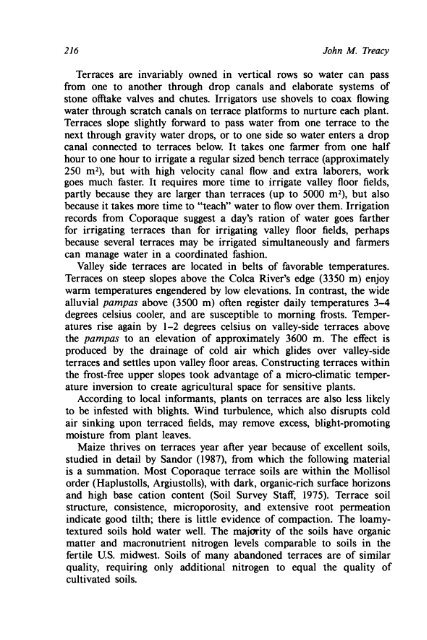Fragile Lands of Latin America Strategies for ... - PART - USAID
Fragile Lands of Latin America Strategies for ... - PART - USAID
Fragile Lands of Latin America Strategies for ... - PART - USAID
You also want an ePaper? Increase the reach of your titles
YUMPU automatically turns print PDFs into web optimized ePapers that Google loves.
John M. Treacy<br />
Terraces are invariably owned in vertical rows so water can pass<br />
from one to another through drop canals and elaborate systems <strong>of</strong><br />
stone <strong>of</strong>ftake valves and chutes. Irrigators use shovels to coax flowing<br />
water through scratch canals on terrace plat<strong>for</strong>ms to nurture each plant.<br />
Terraces slope slightly <strong>for</strong>ward to pass water from one terrace to the<br />
next through gravity water drops, or to one side so water enters a drop<br />
canal connected to terraces below. It takes one farmer from one half<br />
hour to one hour to irrigate a regular sized bench terrace (approximately<br />
250 m2), but with high velocity canal flow and extra laborers, work<br />
goes much faster. It requires more time to irrigate valley floor fields,<br />
partly because they are larger than terraces (up to 5000 m2), but also<br />
because it takes more time to "teach" water to flow over them. Irrigation<br />
records from Coporaque suggest a day's ration <strong>of</strong> water goes farther<br />
<strong>for</strong> irrigating terraces than <strong>for</strong> irrigating valley floor fields, perhaps<br />
because several terraces may be irrigated simultaneously and farmers<br />
can manage water in a coordinated fashion.<br />
Valley side terraces are located in belts <strong>of</strong> favorable temperatures.<br />
Terraces on steep slopes above the Colca River's edge (3350 m) enjoy<br />
warm temperatures engendered by low elevations. In contrast, the wide<br />
alluvial pampas above (3500 m) <strong>of</strong>ten register daily temperatures 3-4<br />
degrees celsius cooler, and are susceptible to morning frosts. Temper-<br />
atures rise again by 1-2 degrees celsius on valley-side terraces above<br />
the pampas to an elevation <strong>of</strong> approximately 3600 m. The effect is<br />
produced by the drainage <strong>of</strong> cold air which glides over valley-side<br />
terraces and settles upon valley floor areas. Constructing terraces within<br />
the frost-free upper slopes took advantage <strong>of</strong> a micro-climatic temper-<br />
ature inversion to create agricultural space <strong>for</strong> sensitive plants.<br />
According to local in<strong>for</strong>mants, plants on terraces are also less likely<br />
to be infested with blights. Wind turbulence, which also disrupts cold<br />
air sinking upon terraced fields, may remove excess, blight-promoting<br />
moisture from plant leaves.<br />
Maize thrives on terraces year after year because <strong>of</strong> excellent soils,<br />
studied in detail by Sandor (1987), from which the following material<br />
is a summation. Most Coporaque terrace soils are within the Mollisol<br />
order (Haplustolls, Argiustolls), with dark, organic-rich surface horizons<br />
and high base cation content (Soil Survey Staff, 1975). Terrace soil<br />
structure, consistence, microporosity, and extensive root permeation<br />
indicate good tilth; there is little evidence <strong>of</strong> compaction. The loamy-<br />
textured soils hold water well. The majority <strong>of</strong> the soils have organic<br />
matter and macronutrient nitrogen levels comparable to soils in the<br />
fertile U.S. midwest. Soils <strong>of</strong> many abandoned terraces are <strong>of</strong> similar<br />
quality, requiring only additional nitrogen to equal the quality <strong>of</strong><br />
cultivated soils.

















